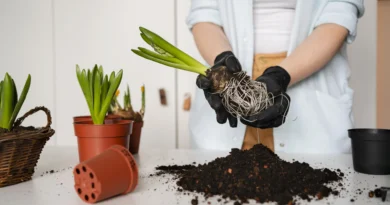Top 5 Gardening Hacks You Need to Know
Table of Contents
ToggleI. Introduction
A beautiful garden can bring joy and tranquility to any home. However, gardening can sometimes be a daunting task, requiring a lot of time, effort, and expertise. But fret not, as we bring to you the top 5 gardening hacks that will not only simplify your gardening journey but also enhance your results. Whether you are a novice or an experienced gardener, these hacks are sure to save you time and help you achieve that lush, thriving garden you’ve always dreamed of.
A. Use Raised Beds for Efficient Gardening
Raised beds are an excellent way to maximize space and improve the quality of your garden. By creating elevated beds, you can better control the soil quality, drainage, and weed growth. This hack is especially useful if you have poor soil conditions or limited space. Additionally, raised beds make gardening more accessible by reducing the strain on your back and knees.
For an efficient raised bed, use a mix of high-quality soil and compost. This will provide your plants with the necessary nutrients and promote healthy growth. Furthermore, consider installing a drip irrigation system to ensure your plants receive an adequate water supply without wastage.
B. Harness the Power of Companion Planting
Companion planting involves strategically placing different plant species together to enhance growth, attract beneficial insects, and repel pests. This natural gardening technique is an organic alternative to chemical pesticides and fertilizers. For example, planting marigolds alongside vegetables such as tomatoes helps repel aphids and nematodes.
Other popular companion planting combinations include basil with tomatoes, which improves the flavor and enhances the yield, and carrots with onions or leeks, which repel carrot flies. By harnessing the power of companion planting, you can create a harmonious garden ecosystem that improves overall plant health and reduces the need for chemical interventions.
II. Section 1: Maximizing Sunlight Exposure
A. Optimize Plant Placement
Plants that require full sunlight should be positioned in areas that receive direct sunlight for at least six hours a day. Conversely, shade-loving plants should be placed in areas with filtered or partial sunlight. Understanding the light requirements of your plants and strategically placing them accordingly will ensure they thrive.
B. Utilize Reflective Surfaces
A simple yet effective hack to maximize sunlight exposure is to use reflective surfaces. Place reflective materials like aluminum foil or mirrors around your plants, directing sunlight towards them. This helps plants receive more light, especially in areas with limited sunlight or shade.
III. Section 2: Efficient Watering Techniques
A. Mulching for Water Conservation
Mulching involves covering the soil surface around your plants with organic materials like straw, wood chips, or leaves. This technique helps retain moisture, regulate soil temperature, and suppress weed growth. By mulching your garden beds, you can significantly reduce water evaporation, conserve moisture, and minimize the need for frequent watering.
B. Watering at Optimum Times
Watering your plants during the early morning or late evening is ideal for efficient water absorption. In these cooler hours, less water is lost to evaporation, and the plants have ample time to uptake the moisture before the heat of the day. Avoid watering during midday when the sun is strongest, as this leads to quicker evaporation and less water reaching the plant roots.
IV. Section 3: Weed Control
A. Layering Newspaper or Cardboard
An effective and eco-friendly method to control weed growth is by layering newspapers or cardboard around your plants. By covering the soil surface around the plants, you block sunlight and prevent weed germination. Additionally, this layer breaks down over time, enriching the soil with organic matter.
B. Organic Weed Suppressants
Herbs like mint or chives can be strategically planted near susceptible areas to naturally repel weeds. These plants emit strong scents that act as a deterrent for weed growth. Additionally, organic mulches like cocoa husks, straw, or wood chips can be used to suppress weed growth and enhance soil fertility.
V. Conclusion
Gardening doesn’t have to be intimidating or time-consuming. By utilizing these top 5 gardening hacks, you can simplify your gardening routine, save time, and achieve remarkable results. From creating raised beds to harnessing the power of companion planting, optimizing sunlight exposure to efficient watering techniques, and controlling weeds naturally, these hacks will make your gardening journey enjoyable and fruitful.
So what are you waiting for? It’s time to unleash your green thumb and transform your garden into a thriving paradise!
VI. FAQ
Q1: Can I use any type of soil in my raised beds?
A1: While you can use any type of soil, it’s recommended to use a mix of high-quality soil and compost for optimal plant growth and nutrition.
Q2: How often should I water my plants?
A2: The watering frequency depends on various factors such as the plant type, weather conditions, and soil moisture levels. It’s best to monitor the moisture levels and water your plants when the top inch of soil feels dry.
Q3: Can I compost the newspaper or cardboard used for weed control?
A3: Yes, once the newspaper or cardboard breaks down, it can be safely added to your compost pile. However, make sure to remove any glossy or colored paper before composting.
Q4: Is it necessary to refresh the mulch regularly?
A4: Over time, organic mulch breaks down and decomposes. It’s recommended to refresh the mulch layer every year or as needed to maintain its effectiveness in conserving moisture and suppressing weeds.





Pingback: Gardening 101: Expert Advice on Soil Preparation and Planting